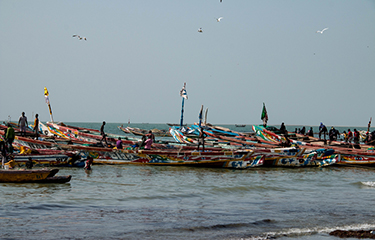The Gambia, a tiny West Africa nation with an 80-kilometer-long coastline, has big plans to increase its total fish production to 75,000 metric tons (MT) from the current estimate of 53,719 MT, but pressure from a global network of illegal and unsustainable fishing activities – and the government’s inability to reverse collapsing industrial fishing – is weighing heavily against projected catch volumes.
In its current National Development Plan for 2018 to 2021, The Gambia is also anticipating to increase fish and fish product exports from 32 to 43 percent, and intends to raise national budget allocation to the aquaculture sector from GMD 2 million (USD 39,000, EUR 35,500) to GMD 10 million (USD 195,000, EUR 177,800) by the end of the plan period.
But these ambitious goals are running against mounting obstacles hampering the growth of The Gambia’s fisheries and aquaculture sector.
“Industrial fishing for local processing has nearly collapsed, and exports have plummeted due to increased illegal fishing, poor surveillance of the fisheries resources in the high seas, unsustainable number of commercial fishing licenses, declining landed catches, high cost of energy needed for processing, and The Gambia’s inability to comply with stringent sanitary and phyto-sanitary requirements in the E.U. market,” the development plan states. “The fisheries sector is faced with high attrition rate of trained and skilled workers, limited access to funding for the sustainable provision of adequate raw materials, a relatively small output making it difficult for the sector to make a mark on any market, while energy costs associated with the sector are very high and unpredictable.”
In addition, the government of Gambia President Adama Barrow, who came into office following the removal of former dictator Yahya Jammeh in 2017, identifies in the development plan more factors linked to the stunted growth of fisheries sector such as an “incomprehensive and incoherent legal and policy framework, absence of a dedicated and deep-water fishing port or well-equipped fishing jetty, and inadequate repair and maintenance services, domination of the fishing sector by non-Gambians including ownership of fishing vessels, processing plants and the landing of most Gambian fish and processing outside of the country.”
A previous report by the United Nations Conference on Trade and Development (UNCTAD) said more than 90 percent of the fishing vessels legally operating in Gambian waters are foreign-owned and land their catch abroad, and hence cannot meet the requirement to land at least 10 percent of their catch in the country because of “lack of handling space in the existing Gambian factories.”
The foreign vessels instead pay the government of The Gambia the value of the 10 percent, and industrial catches caught in Gambian waters but landed in foreign ports for processing and further value-addition are exported “not as products of Gambia but as products of those countries where the catches have been landed.”
In fact, in mid-October 2019 a new report by the Dutch-based Changing Markets Foundation (CMF) said The Gambia is one of three countries in the world where a thriving global fishmeal and fish oil industry is stripping the “oceans bare damaging marine ecosystems to feed the booming aquaculture industry.”
The report, which links the world’s biggest supermarkets and illegal, unsustainable fishing, further said The Gambia, alongside India and Vietnam, were leading suppliers of “feed ingredients for farmed seafood products in high-income markets.”
The Gambia, where one fishmeal and fish oil plant is estimated to consume more than 40 percent of the country’s total catch, says in its development plan there is weak “engagement of private sector in the fishery sector compared to cash-crop agriculture, especially relating to post-harvest processes such as refrigeration, transport, processing, certification of product attributes and marketing.”
However, the government plans in the next two years to ensure adequate and reliable physical, institutional, and financial systems to woo more private-sector players, which it says has great potential, investment opportunities in “capture fisheries management, mangrove habitat restoration, and aquaculture development.”
The Gambia is, therefore, looking forward to intensifying reforms in its fisheries and aquaculture sector that would also include addressing the palpable inadequate empowerment of women, high vulnerability of the fisheries sector to climate change, and natural disasters and damages to lucrative fish species by predator species. These reforms are intended to drive an increase to the sector’s contribution to the country’s economy by 15 percent from the current estimated 6.4 percent, according to the development plan.
An additional boost for The Gambia’s fisheries and aquaculture sector is anticipated once the World Bank-supported West Africa Regional Fisheries Project (WARFP), which the country joined recently, is fully implemented. With the project, The Gambia's government is hoping to double down in its endeavor to revamp existing capacity for fisheries governance and management and to more effectively tackle illegal fishing, in addition to increasing local value added to fish products.
Photo coutersy of evenfh/Shutterstock







